初中英语八种时态整理
初中英语语法总结8种时态
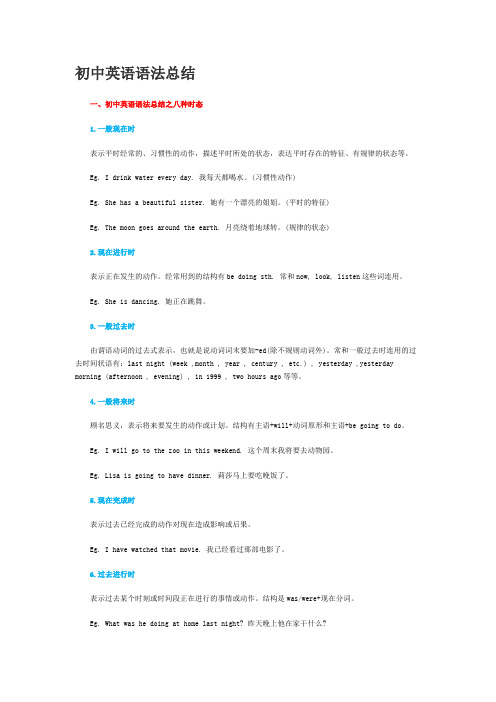
初中英语语法总结一、初中英语语法总结之八种时态1.一般现在时表示平时经常的、习惯性的动作,描述平时所处的状态,表达平时存在的特征、有规律的状态等。
Eg. I drink water every day. 我每天都喝水。
(习惯性动作)Eg. She has a beautiful sister. 她有一个漂亮的姐姐。
(平时的特征)Eg. The moon goes around the earth. 月亮绕着地球转。
(规律的状态)2.现在进行时表示正在发生的动作。
经常用到的结构有be doing sth. 常和now, look, listen这些词连用。
Eg. She is dancing. 她正在跳舞。
3.一般过去时由谓语动词的过去式表示,也就是说动词词末要加-ed(除不规则动词外)。
常和一般过去时连用的过去时间状语有:last night (week ,month , year , century , etc.) , yesterday ,yesterday morning (afternoon , evening) , in 1999 , two hours ago等等。
4.一般将来时顾名思义,表示将来要发生的动作或计划。
结构有主语+will+动词原形和主语+be going to do。
Eg. I will go to the zoo in this weekend. 这个周末我将要去动物园。
Eg. Lisa is going to have dinner. 莉莎马上要吃晚饭了。
5.现在完成时表示过去已经完成的动作对现在造成影响或后果。
Eg. I have watched that movie. 我已经看过那部电影了。
6.过去进行时表示过去某个时刻或时间段正在进行的事情或动作。
结构是was/were+现在分词。
Eg. What was he doing at home last night? 昨天晚上他在家干什么?7.过去将来时表示过去的某时以后将要发生的动作。
初中英语八种基本时态总结

初中英语八种基本时态总结1、概念:1)表示过去某个时间发生的动作或存在的状态。
例:I went to the park yesterday.He was sick last week.2)表示过去的惯性动作,常与表示频度的时间状语连用,但要用过去式的时间状语。
例:I used to play basketball every day after school.3)表示过去的客观真理或科学事实。
例:Newton discovered the law of gravity in 1687.4)表示过去的虚拟语气。
例:If I had known the truth。
I would have told you.2、结构:表状态S+was/were+P表动作S+V过去式+O3、句式变化:变疑问,把was/were提到主语前。
变否定,在was/were后加“not”。
例:①I visited my grandparents last weekend。
→Did you visit your grandparents last weekend。
Yes。
I did。
/ No。
I didn’t。
→I didn’t visit my grandparents last weekend.②She was happy to see her old friend。
→Was she happy to see her old friend。
Yes。
she was。
/ No。
she wasn’t。
→She wasn’t happy to see her old friend.No。
I'm not。
→ I'm not writing a letter now.②They are watching TV at this time。
→ Are they watching TV at this time。
Yes。
they are。
初中英语语法八大时态总结(完整版)
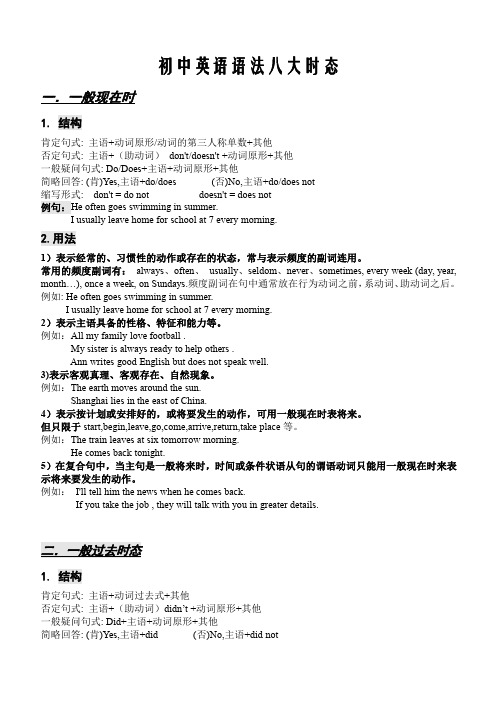
初中英语语法八大时态一.一般现在时1. 结构肯定句式: 主语+动词原形/动词的第三人称单数+其他 否定句式: 主语+(助动词) don't/doesn't +动词原形+其他 一般疑问句式: Do/Does+主语+动词原形+其他 简略回答: (肯)Yes,主语+do/does (否)No,主语+do/does not 缩写形式: don't = do not doesn't = does not 例句:He often goes swimming in summer. I usually leave home for school at 7 every morning.2.用法1)表示经常的、习惯性的动作或存在的状态,常与表示频度的副词连用。
常用的频度副词有: always、often、 usually、seldom、never、sometimes, every week (day, year, month…), once a week, on Sundays.频度副词在句中通常放在行为动词之前, 系动词、 助动词之后。
例如: He often goes swimming in summer. I usually leave home for school at 7 every morning. 2)表示主语具备的性格、特征和能力等。
例如:All my family love football . My sister is always ready to help others . Ann writes good English but does not speak well. 3)表示客观真理、客观存在、自然现象。
例如:The earth moves around the sun. Shanghai lies in the east of China. 4)表示按计划或安排好的,或将要发生的动作,可用一般现在时表将来。
初中英语八大时态归纳总结
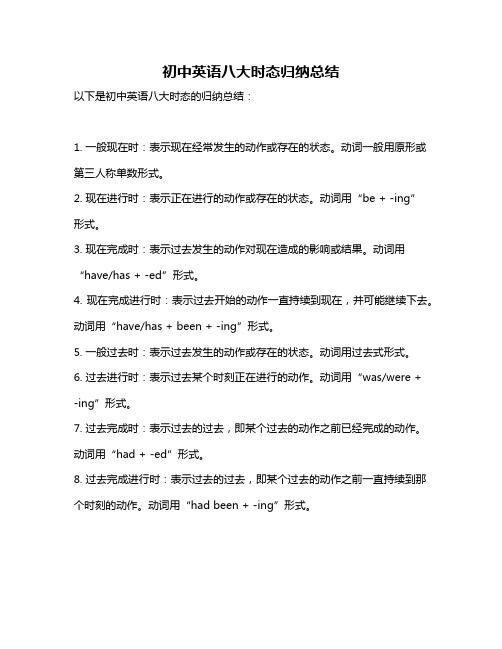
初中英语八大时态归纳总结
以下是初中英语八大时态的归纳总结:
1. 一般现在时:表示现在经常发生的动作或存在的状态。
动词一般用原形或第三人称单数形式。
2. 现在进行时:表示正在进行的动作或存在的状态。
动词用“be + -ing”
形式。
3. 现在完成时:表示过去发生的动作对现在造成的影响或结果。
动词用“have/has + -ed”形式。
4. 现在完成进行时:表示过去开始的动作一直持续到现在,并可能继续下去。
动词用“have/has + been + -ing”形式。
5. 一般过去时:表示过去发生的动作或存在的状态。
动词用过去式形式。
6. 过去进行时:表示过去某个时刻正在进行的动作。
动词用“was/were + -ing”形式。
7. 过去完成时:表示过去的过去,即某个过去的动作之前已经完成的动作。
动词用“had + -ed”形式。
8. 过去完成进行时:表示过去的过去,即某个过去的动作之前一直持续到那个时刻的动作。
动词用“had been + -ing”形式。
以上是初中英语的八大时态,理解和掌握这些时态对于英语学习和交流非常重要。
初中英语8个时态归纳总结
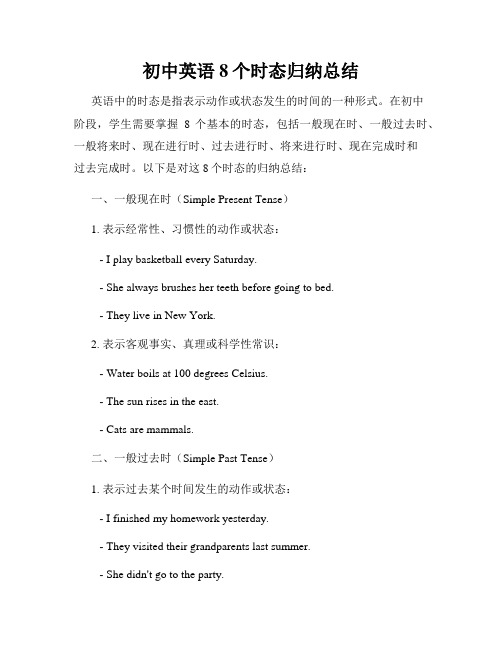
初中英语8个时态归纳总结英语中的时态是指表示动作或状态发生的时间的一种形式。
在初中阶段,学生需要掌握8个基本的时态,包括一般现在时、一般过去时、一般将来时、现在进行时、过去进行时、将来进行时、现在完成时和过去完成时。
以下是对这8个时态的归纳总结:一、一般现在时(Simple Present Tense)1. 表示经常性、习惯性的动作或状态:- I play basketball every Saturday.- She always brushes her teeth before going to bed.- They live in New York.2. 表示客观事实、真理或科学性常识:- Water boils at 100 degrees Celsius.- The sun rises in the east.- Cats are mammals.二、一般过去时(Simple Past Tense)1. 表示过去某个时间发生的动作或状态:- I finished my homework yesterday.- They visited their grandparents last summer.- She didn't go to the party.2. 表示过去的经历或习惯:- When I was young, I often went swimming. - He always ate breakfast at 8 o'clock.三、一般将来时(Simple Future Tense)1. 表示将来要发生的动作或事件:- I will go shopping tomorrow.- They are going to have a picnic next week. - She won't be late for the meeting.2. 表示将来的打算或意愿:- I am going to be a doctor when I grow up.- We will help you with your project.四、现在进行时(Present Continuous Tense)1. 表示现在正在进行的动作:- We are studying English at the moment.- He is playing soccer with his friends.- They aren't watching TV right now.2. 表示现阶段的趋势或变化:- The population is increasing rapidly.- More and more people are using smartphones.五、过去进行时(Past Continuous Tense)1. 表示过去某一时间段内正在进行的动作:- I was reading a book when the phone rang.- They were cooking dinner at 7 o'clock.2. 表示过去的同时发生的两个动作:- She was listening to music while doing her homework.六、将来进行时(Future Continuous Tense)1. 表示将来某一时间段内正在进行的动作:- Tomorrow, they will be flying to Paris.- I will be waiting for you at the station.2. 表示将来的预测或计划:- This time next month, I will be studying for my exams.七、现在完成时(Present Perfect Tense)1. 表示过去某一时间发生的动作对现在造成的影响或结果: - I have finished my homework, so I can watch TV now.- She has already eaten lunch.2. 表示过去某一时间内多次发生的动作:- We have visited that museum several times.八、过去完成时(Past Perfect Tense)1. 表示过去某一时间点之前已经完成的动作:- By the time they arrived, we had already left.- I had finished my work before the deadline.2. 表示过去的顺序或先后关系:- She realized that she had forgotten her keys after she locked the door.以上是初中英语的8个时态的归纳总结。
(完整版)初中英语八种时态总结归纳

初中英语八种时态总结归纳一、一般现在时:概念:经常、反复发生的动作或行为及现在的某种状况。
时间状语:often,usually,always,sometimes,every week(day,year,month...),once a week,on sundays,etc.基本结构:①be动词;②行为动词否定形式:①am /is /are +not;②此时态的谓语动词若为行为动词,则在其前加don't,如主语为第三人称单数,则用doesn't,同时还原行为动词。
一般疑问句:①把be动词放于句首;②用助动词do提问,如主语为第三人称单数,则用does,同时,还原行为动词。
二、一般过去时:概念:过去某个时间里发生的动作或状态;过去习惯性、经常性的动作、行为。
时间状语:ago,yesterday,the day before yesterday,last week(year,night,month...),in 1989,just now,at the age of 5,one day,long long ago,once upon a time,etc.基本结构:①be动词;②行为动词否定形式:① was/were +not;②在行为动词前加didn't,同时还原行为动词。
一般疑问句:①was或were放在句首;②用助动词do的过去式did提问,同时还原行为动词。
三、现在进行时:概念:表示现阶段或说话时正在进行的动作及行为。
时间状语:now,at this time,these days,etc.基本结构:am/is/are +doing否定形式:am/is/are +not+doing一般疑问句:把be动词放在句首四、过去进行时:概念:表示过去某段时间或某一时刻正在发生或进行的行为或动作。
时间状语:at this time yesterday,at that time或以when引导的谓语动词是一般过去时的时间状语等。
初中英语语法八大时态总结完整版
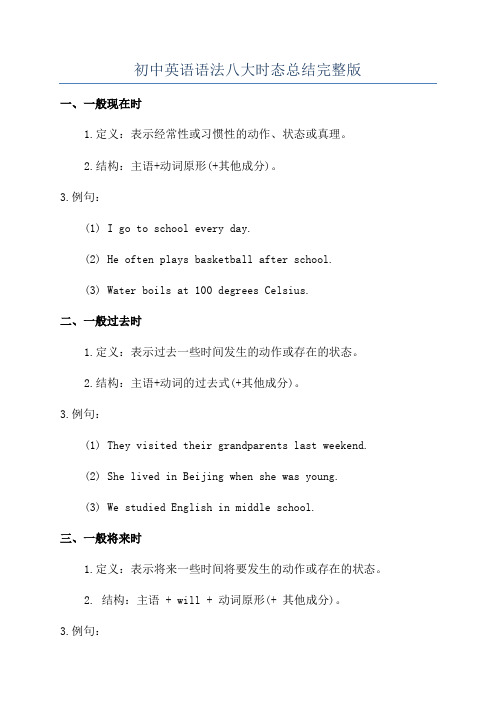
初中英语语法八大时态总结完整版一、一般现在时1.定义:表示经常性或习惯性的动作、状态或真理。
2.结构:主语+动词原形(+其他成分)。
3.例句:(1) I go to school every day.(2) He often plays basketball after school.(3) Water boils at 100 degrees Celsius.二、一般过去时1.定义:表示过去一些时间发生的动作或存在的状态。
2.结构:主语+动词的过去式(+其他成分)。
3.例句:(1) They visited their grandparents last weekend.(2) She lived in Beijing when she was young.(3) We studied English in middle school.三、一般将来时1.定义:表示将来一些时间将要发生的动作或存在的状态。
2. 结构:主语 + will + 动词原形(+ 其他成分)。
3.例句:(1) I will go to the park tomorrow.(3) We will have a party next week.四、现在进行时1.定义:表示现在正在进行的动作。
2. 结构:主语 + am/is/are + 动词-ing(+ 其他成分)。
3.例句:(1) She is reading a book right now.(2) They are playing soccer in the park.(3) We are having dinner at the moment.五、过去进行时1.定义:表示过去一些时间正在进行的动作。
2. 结构:主语 + was/were + 动词-ing(+ 其他成分)。
3.例句:(1) He was watching TV at 8 o'clock last night.(2) They were traveling in Europe during summer vacation.(3) We were studying when the phone rang.六、将来进行时1.定义:表示将来一些时间正在进行的动作。
初中英语八种基本时态总结
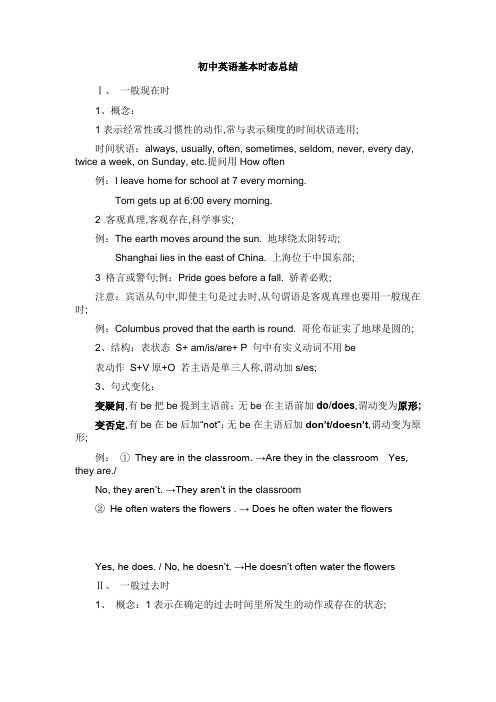
初中英语基本时态总结Ⅰ、一般现在时1、概念:1表示经常性或习惯性的动作,常与表示频度的时间状语连用;时间状语:always, usually, often, sometimes, seldom, never, every day, twice a week, on Sunday, etc.提问用How often例:I leave home for school at 7 every morning.Tom gets up at 6:00 every morning.2 客观真理,客观存在,科学事实;例:The earth moves around the sun. 地球绕太阳转动;Shanghai lies in the east of China. 上海位于中国东部;3 格言或警句;例:Pride goes before a fall. 骄者必败;注意:宾语从句中,即使主句是过去时,从句谓语是客观真理也要用一般现在时;例:Columbus proved that the earth is round. 哥伦布证实了地球是圆的;2、结构:表状态S+ am/is/are+ P 句中有实义动词不用be表动作S+V原+O 若主语是单三人称,谓动加s/es;3、句式变化:变疑问,有be把be提到主语前;无be在主语前加do/does,谓动变为原形;变否定,有be在be后加“not”;无be在主语后加don’t/doesn’t,谓动变为原形;例:①They are in the classroom. →Are they in the classroom Yes, they are./No, they aren’t. →They aren’t in the cl assroom②He often waters the flowers . → Does he often water the flowersYes, he does. / No, he doesn’t. →He doesn’t often water the flowersⅡ、一般过去时1、概念:1表示在确定的过去时间里所发生的动作或存在的状态;常用时间状语:yesterday, the day before yesterday, last week, just now, an hour ago, the other day, in 1982. at the age of 5, one day, long long ago, etc.例:Where did you go just now2表示在过去一段时间内,经常性或习惯性的动作;例:When I was a child, I often played football in the street.2、结构:表状态S+ was/were+ P表动作S+V过去式+O 注:句中有实义动词不用be3、句式变化:变疑问,有be把be提到主语前;无be在主语前加did,谓动变为原形;变否定,有be在be后直接加“not”;无be在主语后加didn’t,谓动变为原形.例:①She was in Xi’an last month. → Was she in Xi’an last monthYes, she was. /No, she wasn’t. →She wasn’t in Xi’an last month.②Danny grew a rose just now, → Did Danny grow a rose just nowYes, he did. / No, he didn’t. →Danny didn’t grow a rose just now,Ⅲ、现在进行时:1. 概念:表示现阶段或说话时正在进行的动作;时间状语:now, at this time, these days,以及有look, listen时;例:ListenThe birds are singing.2、结构:S + am/is/are + doing助动现在分词3、句式变化:变疑问,把am/is/are提到主语前;变否定,在am/is/are后直接加“not”;例:①I am writing a letter now. → Are you writing a letter nowYes, I am. /No, I’m not. →I am not writing a letter now. 注:am和not不能缩写;②The boys are playing football. → Are the boys playing footballYes, they are. / No, they aren’t. →The boys aren’t playing football.Ⅳ、过去进行时:1. 概念:表示过去某段时间或某一时刻正在发生或进行的动作;.时间状语:at this time yesterday, at that time,at 8:00 yesterday,或有when / while引导的时间状语从句等;例:We were having an English class at 9:30 yesterday morning.I was reading a book while my mother was watching TV.2、结构:S + was/were + doing3、句式变化:变疑问,把was/were提到主语前;变否定,在was/were后直接加“not”;例:①At that time they were working in the garden. → Were they working inthe garden at that timeYes, they were. / No, they weren’t.→At that time they were working in the garden.②When he came in, I was reading a newspaper. →When he came in, were you reading a newspaperYes, I was. / No, I wasn’t.→When he came in, I wasn’t reading a newspaper.Ⅴ、一般将来时1. 概念:表示将要发生的动作或存在的状态;时间词:tomorrow, tomorrow morning, at seven o'clock tomorrow evening, next year, this year, at the end of this term, from now,in ten minutes, in 2025例:They will do an experiment tomorrow afternoon.Brian is going to draw twenty pictures at the end of this term.2、结构:S +will+ V原+其他will 可改为be going to ,当主语是第一人称时will可用shall例:Which paragraph shall I read first 我先读哪一段呢Will you/Are you going tobe at home at seven this evening3、句式变化:变疑问,把will提到主语前;变否定,在will后直接加“not”;例; She will drive to Beijing next week. → Will she drive to Beijing next weekYes, she will. / No, she won’t. →She won’t drive to Beijing next week.★be going to + V原表示a. 主语的意图,即将做某事;例:What are you going to do tomorrowb. 计划,安排要发生的事;例:The play is going to be produced next month;c. 有迹象要发生的事;例:Look at the dark clouds, there is going to be a storm.★be +不定式:表示将来,按计划或正式安排将发生的事;例:We are to discuss the report next Saturday. 我们下星期六将讨论这份报告★用现在进行时表示将来come, go, arrive, leave, start, begin, return等终止性动词可用现在进行时表示将来;例:I'm leaving tomorrow. 明天我要走了;Are you staying here till next week 你会在这儿呆到下周吗Ⅶ、现在完成时:1. 表示:①过去发生或已经完成的动作对现在造成的影响或结果;时间词:ever, never, already, yet, before, just, recently/ lately最近, in the past few years2. ②或从过去已经开始持续到现在的动作或状态; 时间词:for + 时间段,since +过去时间点/从句;提问用How long例:The countryside has changed a lot in the past few years.He has learned French for two years.2.结构:S + have/has + done助动过去分词3. 句式变化:变疑问,把have/has提到主语前;变否定,在have/has后直接加“not”;例:①I've already written an article. → Have you written an article yet Yes, I h ave. / No, I haven’t. →I haven’t written an article yet.②Li Ming has lived in Shijiazhuang since 1993.→ Has Li Ming lived in Shijiazhuang since 1993 Yes, he has. / No, he hasn’t.→Li Ming hasn’t lived in Shijiazhuang since 1993.★比较一般过去时与现在完成时1一般过去时表示过去某具体时间发生的动作或单纯叙述过去的事情,强调动作;现在完成时则强调过去发生的动作对现在的造成影响,强调的是结果;2一般过去时常与具体的时间状语连用,而现在完成时通常与模糊的时间状语连用,或无时间状语;例:I saw this film yesterday. 强调看的动作发生过了I have seen this film. 强调对现在的影响,电影的内容已经知道了Why did you get up so early 强调起床的动作已发生过了Who hasn't handed in his paper 强调有卷子未交,指结果He joined the League three years ago. 强调加入这一动作He has been a League member for three years. 是团员的状态可持续句子中如有过去时的时间副词如yesterday, last, week, in 1960时,不能使用现在完成时,要用过去时;错Tom has written a letter to his parents last night.对Tom wrote a letter to his parents last night.。
初中英语八大时态笔记
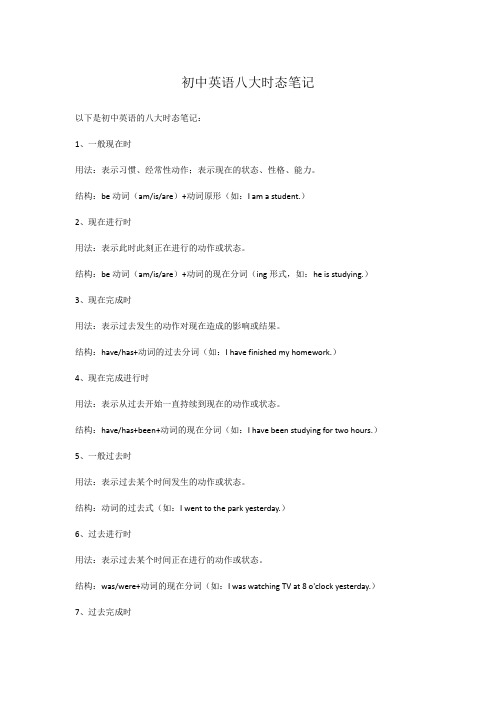
初中英语八大时态笔记以下是初中英语的八大时态笔记:1、一般现在时用法:表示习惯、经常性动作;表示现在的状态、性格、能力。
结构:be动词(am/is/are)+动词原形(如:I am a student.)2、现在进行时用法:表示此时此刻正在进行的动作或状态。
结构:be动词(am/is/are)+动词的现在分词(ing形式,如:he is studying.)3、现在完成时用法:表示过去发生的动作对现在造成的影响或结果。
结构:have/has+动词的过去分词(如:I have finished my homework.)4、现在完成进行时用法:表示从过去开始一直持续到现在的动作或状态。
结构:have/has+been+动词的现在分词(如:I have been studying for two hours.)5、一般过去时用法:表示过去某个时间发生的动作或状态。
结构:动词的过去式(如:I went to the park yesterday.)6、过去进行时用法:表示过去某个时间正在进行的动作或状态。
结构:was/were+动词的现在分词(如:I was watching TV at 8 o'clock yesterday.)7、过去完成时用法:表示在过去某个时间之前已经完成的动作或状态。
结构:had+动词的过去分词(如:I had finished my homework before dinner.)8、过去完成进行时用法:表示在过去某个时间之前一直持续到那个时间的动作或状态。
结构:had been+动词的现在分词(如:I had been studying for two hours before dinner.)。
初中英语8大时态

– 4. 形式 I am studying. 肯定句 I am not studying. 否定句 Am I studying? 疑问句 Yes,I am/ No,I am not. 简要回答
• 5. 一般现在时和现在进行时的区别 (1) 一般现在时表示经常性或习惯性的动作,现 在进行时表示正在发生的行为。 • a. He is cleaning his room now.他在打扫房间。 • He cleans his room every day.他每天都要打扫房 间。 • b.They are visiting China.他们正在中国观光。 • They often come to China for a visit.他们经常来 中国观光。 • (2) 一般现在时表示现在的状态。 • He likes jiaozi. They have a lot of friends
初中英语八种时态
一、一般现在时 ①be动词;②行为动词 一般时 态 二、一般过去时①be动词;②行为动词 过去时 态 三、现在进行时基本结构:am/is/are+doing 四、过去进行时基本结构:was/were+doing 五、现在完成时基本结构:have/has + done 六、过去完成时基本结构:had + done 七、一般将来时基本结构:①am/is/are/going to + do;②will/shall + do 八、过去将来时基本结构:①was/were/going to + do;②would/should + do
•
二、现在进行时( present continuous te的现在分 词
• 2.用法
• a. 表示现在正在进行或发生的动作。 He is eating an ice cream.他正在吃冰激凌。 • b. 表示当前一段时期内的活动或现阶段正在进行的动作 (说话时不一定正在进行)。 We are working on a farm these days? 这些天我们在一 个农场干活。 c. 表示位置移动或趋向的词,如go,come, start,leave, arrive, move等常用进行时表将来。 He is leaving for Shanghai tomorrow. I'm coming! What's the score now? 我就来!现在比分 是多少? • We are moving to a big house next month. 下个月我们将 搬到一所大房子里。 • d. 与always, constantly, forever 等词连用,表示反复发生 的动作或持续存在的状态,往往带有说话人的主观色彩。 You are always changing your mind.
初中英语八大时态结构及用法
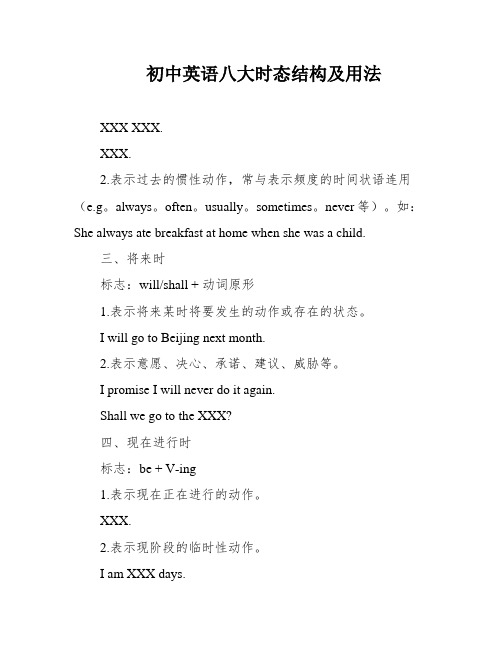
初中英语八大时态结构及用法XXX XXX.XXX.2.表示过去的惯性动作,常与表示频度的时间状语连用(e.g。
always。
often。
usually。
sometimes。
never等)。
如:She always ate breakfast at home when she was a child.三、将来时标志:will/shall + 动词原形1.表示将来某时将要发生的动作或存在的状态。
I will go to Beijing next month.2.表示意愿、决心、承诺、建议、威胁等。
I promise I will never do it again.Shall we go to the XXX?四、现在进行时标志:be + V-ing1.表示现在正在进行的动作。
XXX.2.表示现阶段的临时性动作。
I am XXX days.五、过去进行时标志:was/were + V-ing表示过去某一时刻正在进行的动作。
I was XXX it started to rain.六、现在完成时标志:have/has + 过去分词1.表示过去发生的动作对现在造成的影响或结果。
I have finished my homework。
so I can watch TV now.2.表示动作已经完成,强调完成的结果。
He has written three XXX.七、过去完成时标志:had + 过去分词表示过去某一时刻之前已经完成的动作。
I had XXX XXX.八、将来完成时标志:will have + 过去分词表示将来某一时刻之前已经完成的动作。
By next year。
I will have graduated from university。
时态在英语中是非常重要的语法内容,学好时态基本上就能够掌握语法的大半部分。
英语共有八种时态,分别是一般现在时、一般过去时、将来时、现在进行时、过去进行时、现在完成时、过去完成时和将来完成时。
初中英语八种时态整理
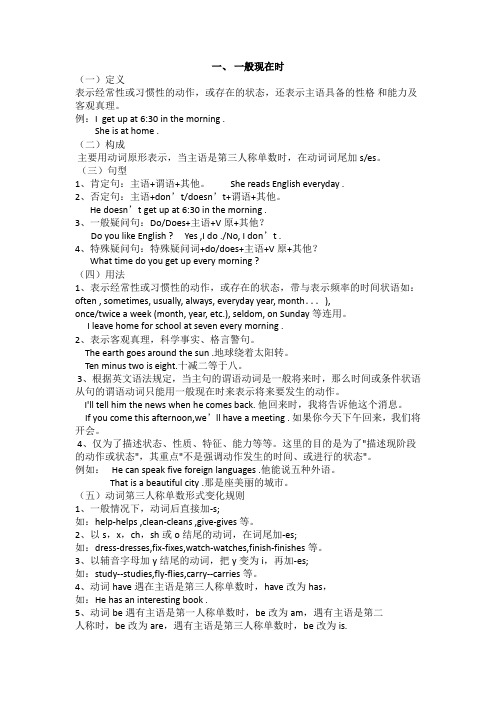
一、一般现在时(一)定义表示经常性或习惯性的动作,或存在的状态,还表示主语具备的性格和能力及客观真理。
例:I get up at6:30in the morning.She is at home.(二)构成主要用动词原形表示,当主语是第三人称单数时,在动词词尾加s/es。
(三)句型1、肯定句:主语+谓语+其他。
She reads English everyday.2、否定句:主语+don’t/doesn’t+谓语+其他。
He doesn’t get up at6:30in the morning.3、一般疑问句:Do/Does+主语+V原+其他?Do you like English?Yes,I do./No,I don’t.4、特殊疑问句:特殊疑问词+do/does+主语+V原+其他?What time do you get up every morning?(四)用法1、表示经常性或习惯性的动作,或存在的状态,带与表示频率的时间状语如:often,sometimes, usually, always, everyday year, month...),once/twice a week(month, year, etc.), seldom, on Sunday等连用。
I leave home for school at seven every morning.2、表示客观真理,科学事实、格言警句。
The earth goes around the sun.地球绕着太阳转。
Ten minus two is eight.十减二等于八。
3、根据英文语法规定,当主句的谓语动词是一般将来时,那么时间或条件状语从句的谓语动词只能用一般现在时来表示将来要发生的动作。
I'll tell him the news when he comes back.他回来时,我将告诉他这个消息。
If you come this afternoon,we’ll have a meeting.如果你今天下午回来,我们将开会。
初中英语必须掌握的8大时态
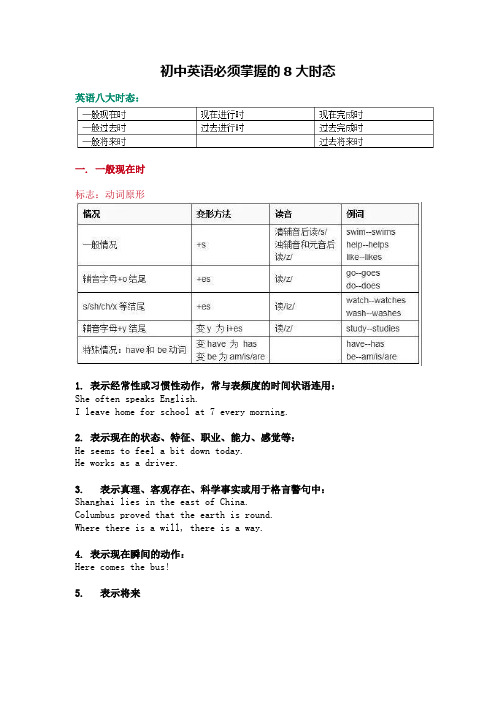
初中英语必须掌握的8大时态英语八大时态:一. 一般现在时标志:动词原形1. 表示经常性或习惯性动作,常与表频度的时间状语连用:She often speaks English.I leave home for school at 7 every morning.2. 表示现在的状态、特征、职业、能力、感觉等:He seems to feel a bit down today.He works as a driver.3. 表示真理、客观存在、科学事实或用于格言警句中:Shanghai lies in the east of China.Columbus proved that the earth is round.Where there is a will, there is a way.4. 表示现在瞬间的动作:Here comes the bus!5. 表示将来1) 表按规定、计划、安排将要发生的动作(仅限于某些表示“来、去、动、停、开始、结束、继续”等的趋向动词),可以与表示未来的时间状语搭配使用。
常见的用法是:飞机、火车、轮船、汽车等定期定点运行的交通状况。
如:The next train leaves at 3 o’clock this afternoon.How often does the shuttle bus run?2) 在时间和条件状语从句中常使用一般现在时表示将来发生的事情:When Bill comes (不用will come), ask him to wait for me.I shall go there tomorrow unless I’m too bus y.二. 一般过去时标志:动词过去式*闭音节:元音字母a, e, i, o, u如果发字母本来的音则称为开音节,否则称为闭音节。
1. 表示过去某时所发生的动作或存在的状态,常与表示过去的时间状语连用(e.g. yesterday, this morning, just now, a moment ago, in May, last night/year / week, once upon a time, the other day, before …,when …, in the past等)。
初中英语的八种时态

初中英语的八种时态一、一般现在时:表示经常、反复发生的动作或行为以及现在的某种状况。
时间状语:always 、usually、ofen 、sometimes ,every week(day,year, month……) ,once a week, on Sundays, etc.基本结构:○1be动词;○2行为动词否定形式:○1am/is/are+not○2此时态的谓语动词如果为行为动词,则在其前加don,t ,如果主语是第三人称,则用doesn,t ,同时还原行为动词。
一般疑问句:○1把be 动词放在句首○2用助动词do 提问,如主语为第三人称单数,则用does,同时还原行为动词。
二、一般过去时:表示过去某个时间里发生的动作或状态;过去习惯性、经常性的动作、行为。
时间状语:ago, yesterday, the day before yesterday,last week (year, month,night (i)2000,just now ,at the age of 10,one day ,long long ago,once upon a time ,etc.基本结构:○1be动词;○2行为动词否定形式:○1was/were+not ○2在行为动词前加didn,t,同时还原行为动词。
一般疑问句:○1把was或were放于句首○2用助动词do的过去式did 提问,同时还原行为动词。
三、现在进行时:表示现阶段或说话时正在进行的动作或行为。
时间状语:now ,at this time ,these days ,etc.基本结构:am /is /are+doing否定形式:am /is /are+not+doing一般疑问句:把be动词放于句首。
四、过去进行时:表示过去某段时间或某一时刻正在发生或进行的行为或动作。
时间状语:at this time yesterday,at that time 或以when 引导的谓语动词是一般过去时的时间状语等。
初中英语8大时态整理
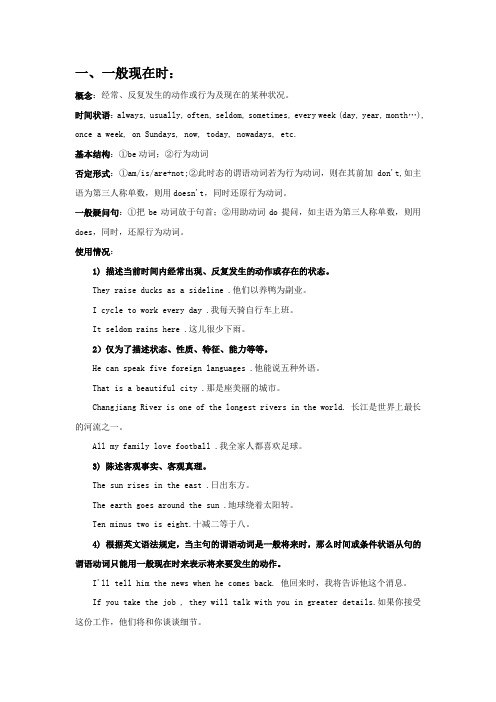
概念:经常、反复发生的动作或行为及现在的某种状况。
时间状语:always, usually, often, seldom, sometimes, every week (day, year, month…), once a week, on Sundays, now, today, nowadays, etc.基本结构:①be动词;②行为动词否定形式:①am/is/are+not;②此时态的谓语动词若为行为动词,则在其前加don't,如主语为第三人称单数,则用doesn't,同时还原行为动词。
一般疑问句:①把be动词放于句首;②用助动词do提问,如主语为第三人称单数,则用does,同时,还原行为动词。
使用情况:1) 描述当前时间内经常出现、反复发生的动作或存在的状态。
They raise ducks as a sideline .他们以养鸭为副业。
I cycle to work every day .我每天骑自行车上班。
It seldom rains here .这儿很少下雨。
2)仅为了描述状态、性质、特征、能力等等。
He can speak five foreign languages .他能说五种外语。
That is a beautiful city .那是座美丽的城市。
Changjiang River is one of the longest rivers in the world. 长江是世界上最长的河流之一。
All my family love football .我全家人都喜欢足球。
3) 陈述客观事实、客观真理。
The sun rises in the east .日出东方。
The earth goes around the sun .地球绕着太阳转。
Ten minus two is eight.十减二等于八。
4) 根据英文语法规定,当主句的谓语动词是一般将来时,那么时间或条件状语从句的谓语动词只能用一般现在时来表示将来要发生的动作。
初中英语 8 大时态结构总结,你都掌握了吗?
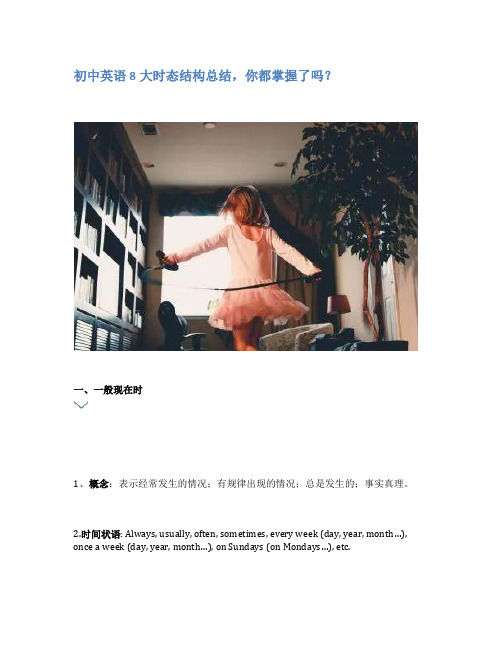
初中英语 8大时态结构总结,你都掌握了吗?一、一般现在时1、概念:表示经常发生的情况;有规律出现的情况;总是发生的;事实真理。
2.时间状语: Always, usually, often, sometimes, every week (day, year, month…), once a week (day, year, month…), on Sundays (on Mondays…), etc.3.基本结构:主语+动词原形(如主语为第三人称单数,动词上要改为第三人称单数形式)4.否定形式:主语+am / is / are+not+其他;此时态的谓语动词若为行为动词,则在其前加 don't,如主语为第三人称单数,则用 doesn't,同时还原行为动词。
5.一般疑问句:把 be 动词放于句首;用助动词 do 提问,如主语为第三人称单数,则用 does,同时,还原行为动词。
eg:①It seldom snows here. 这里很少下雪。
②He is always ready to help others. 他总是乐于帮助别人。
③Action speaks louder than words. 事实胜雄辩。
二、一般过去时1.概念:过去某个时间里发生的动作或状态;过去习惯性、经常性的动作、行为。
2.时间状语:ago, yesterday, the day before yesterday, last week, last(year,night,month…), in 1989, just now, at the age of 5, one day, long long ago, once upon a time,etc.3.基本结构:主语+动词的过去式或 be 的过去式+名词4.否定形式:主语+was / were+not+其他;在行为动词前加didn't,同时还原行为动词。
初中英语语法八大时态总结

1.一般现在时2 .一般过去时3 .一般将来时4 .现在进行时5 .过去进行时6 .现在完成时7 .过去完成时8 .过去将来时1.一般现在时1.一般现在时的构成一般现在时主要用动词原形表示,如果主语是第三人称单数则动词也要用第三人称单数形式。
动词第三人称单数的构成方式如下:构成方法例词一般在词尾加-s work—works;spend—spends在以s,z,ch,sh,x等字母结尾的动词之后加-es pass—passes;wash—washes;teach—teaches;mix—mixes以不发音的e结尾的动词只在e后加-s write—writes;ride—rides 以“辅音字母+y”结尾的动词,变y为i,再加-esstudy—studies;try—tries 以o结尾的动词,在词尾加-es do—does;go—goes2.一般现在时的用法(1)表示经常性或习惯性的动作或存在的状态,常与often,always,usually,sometimes,once a week,every day/...等表示频率的副词或时间状语连用。
如:I often go to school by bike.我经常骑车去上学。
(2)表示客观事实或普遍真理。
如:The earth goes around the sun.地球绕着太阳转。
(3)在时间、条件等状语从句中,用一般现在时表示将来。
如:If it rains tomorrow,we won't go to the park.如果明天下雨,我们将不去公园。
When I grow up,I will go to America.当我长大后,我将去美国。
即学即练( )1.If Nancy ________ the exam ,she will go to Australia for English study.A .passB .passedC .passesD .will pass ( )2.The Greens will visit Hainan as soon as they ________ to China.A .comesB .comeC .cameD .will come ( )3.Now my father ________ his bike to work every day instead of driv ing.A .rideB .rodeC .ridesD .will rideC B C2.一般过去时1.一般过去时的构成一般过去时用动词的过去式表示,即:主语+动词的过去式。
初中英语八大时态归纳

初中英语八大时态归纳如下:
1. 一般现在时:表示通常性、规律性、习惯性的状态或者动作(有时间规律发生的事件)的一种时间状态。
2. 现在进行时:表示正在进行的动作或存在的状态。
3. 现在完成时:过去发生的动作对现在造成的结果。
4. 现在完成进行时:表示从过去开始一直持续到现在的动作或状态。
5. 一般过去时:表示过去某个时间里发生的动作或状态,或过去习惯性、经常性的动作、行为。
6. 过去进行时:表示过去某个时间正在发生的动作或状态。
7. 过去完成时:表示在过去某个时间或动作之前已经完成了动作。
8. 过去完成进行时:表示过去某个时间或动作之前一直在进行的动作或状态。
希望以上信息能够帮助您更好地理解初中英语的八大时态。
初中英语语法八大时态总结(完整版)

初中英语语法八大时态一.一般现在时1. 结构肯定句式: 主语+动词原形/动词的第三人称单数+其他 否定句式: 主语+(助动词) don't/doesn't +动词原形+其他 一般疑问句式: Do/Does+主语+动词原形+其他 简略回答: (肯)Yes,主语+do/does (否)No,主语+do/does not 缩写形式: don't = do not doesn't = does not 例句:He often goes swimming in summer. I usually leave home for school at 7 every morning.2.用法1)表示经常的、习惯性的动作或存在的状态,常与表示频度的副词连用。
常用的频度副词有: always、often、 usually、seldom、never、sometimes, every week (day, year, month…), once a week, on Sundays.频度副词在句中通常放在行为动词之前, 系动词、 助动词之后。
例如: He often goes swimming in summer. I usually leave home for school at 7 every morning. 2)表示主语具备的性格、特征和能力等。
例如:All my family love football . My sister is always ready to help others . Ann writes good English but does not speak well. 3)表示客观真理、客观存在、自然现象。
例如:The earth moves around the sun. Shanghai lies in the east of China. 4)表示按计划或安排好的,或将要发生的动作,可用一般现在时表将来。
- 1、下载文档前请自行甄别文档内容的完整性,平台不提供额外的编辑、内容补充、找答案等附加服务。
- 2、"仅部分预览"的文档,不可在线预览部分如存在完整性等问题,可反馈申请退款(可完整预览的文档不适用该条件!)。
- 3、如文档侵犯您的权益,请联系客服反馈,我们会尽快为您处理(人工客服工作时间:9:00-18:30)。
一、一般现在时(一)定义表示经常性或习惯性的动作,或存在的状态,还表示主语具备的性格和能力及客观真理。
例:I get up at 6:30 in the morning .She is at home .(二)构成主要用动词原形表示,当主语是第三人称单数时,在动词词尾加s/es。
(三)句型1、肯定句:主语+谓语+其他。
She reads English everyday .2、否定句:主语+don’t/doesn’t+谓语+其他。
He doesn’t get up at 6:30 in the morning .3、一般疑问句:Do/Does+主语+V原+其他?Do you like English ? Yes ,I do ./No, I don’t .4、特殊疑问句:特殊疑问词+do/does+主语+V原+其他?What time do you get up every morning ?(四)用法1、表示经常性或习惯性的动作,或存在的状态,带与表示频率的时间状语如:often , sometimes, usually, always, everyday year, month...),once/twice a week (month, year, etc.), seldom, on Sunday等连用。
I leave home for school at seven every morning .2、表示客观真理,科学事实、格言警句。
The earth goes around the sun .地球绕着太阳转。
Ten minus two is eight.十减二等于八。
3、根据英文语法规定,当主句的谓语动词是一般将来时,那么时间或条件状语从句的谓语动词只能用一般现在时来表示将来要发生的动作。
I'll tell him the news when he comes back. 他回来时,我将告诉他这个消息。
If you come this afternoon,we’ll have a meeting . 如果你今天下午回来,我们将开会。
4、仅为了描述状态、性质、特征、能力等等。
这里的目的是为了"描述现阶段的动作或状态",其重点"不是强调动作发生的时间、或进行的状态"。
例如: He can speak five foreign languages .他能说五种外语。
That is a beautiful city .那是座美丽的城市。
(五)动词第三人称单数形式变化规则1、一般情况下,动词后直接加-s;如:help-helps ,clean-cleans ,give-gives等。
2、以s,x,ch,sh或o结尾的动词,在词尾加-es;如:dress-dresses,fix-fixes,watch-watches,finish-finishes等。
3、以辅音字母加y结尾的动词,把y变为i,再加-es;如:study--studies,fly-flies,carry--carries等。
4、动词have遇在主语是第三人称单数时,have改为has,如:He has an interesting book .5、动词be遇有主语是第一人称单数时,be改为am,遇有主语是第二人称时,be改为are,遇有主语是第三人称单数时,be改为is.Exercises:1)用所给单词的正确形式填空。
1.I like ____________ (swim).2.He _________(read) English every day.3.We _________(go)to school at seven in the morning.4.Does he_________(like)_________(jump) ?5.Does Nancy_________(grow)flowers on Saturday ?6. Why__________Tom absent today ? ( be )7. _________you study English at school ? Yes , I___________. ( do )8. __________your sister study English at school ? No , she__________ . ( do ) 2)单项选择题1.The students will go to the Summer Palace if it _____ tomorrow.A.don't rainB. doesn't rainC. won't rain2. There _____ an English film next week.A. will haveB. is going to haveC. is going to beD. was going to be3. The picture _______ nice.A.looksB.is lookedC.lookD.is looking4. She ______ down and soon fell asleep. A. live B. lain C. laid D. lay5. They _____ the office at nine yesterday morning.A. reached toB. arrivedC. wentD. get to6. We shall go to Shanghai on business before you _____ back next week.A. will comeB. cameC. would comeD. come7. Don't smoke until the plane ______ off.A.takesB.tookC.was takenD.is take8. I saw her ____ the room this morning.A.to enterB. enteredC. enterD. enters9.the teacher asked us ______ to school on time.A. to comeingees10. Jim decided _______ Polly to Ling Feng when he was back to England.A. to leaveB. leftC. leavingD. Leave二、一般过去时:(一)定义过去某个时间里发生的动作或状态;过去习惯性、经常性的动作、行为。
例:I was born on April 2, 1986.(二)结构1、肯定句:主语+动词过去式+其他。
I was in Beijing yesterday . I went to the beach yesterday .2、否定句:主语+wasn’t 或weren’t+其他。
主语+didn’t + V原+其他。
I wasn’t in Beijing yesterday . I didn’t go to the beach yesterday .3、一般疑问句:was/ were+主语+V原+其他?Did +主语+V原+其他?Were you in Beijing yesterday ? Did you go to the beach yesterday ?4、特殊疑问句:特殊疑问词+ was/ were+主语+其他?特殊疑问词+did+主语+V原+其他?Where were you yesterday ? Where did you go yesterday ?(三)用法1、表示过去某一时刻或某一段时间里所发生的动作或情况,常与明确的时间状语连用,如:yesterday,last week(month,year...)…ago,the other day ,just now ,at the age of…,in 1980等连用。
如: At the age of ten ,she began to learn to play the piano .2、表示过去经常发生或反复发生的动作,常与表示频度的时间状语连用。
When I was a child ,I often play the football in the street .3、在时间、条件状语从句中,常用一般过去时态代替过去将来时。
He said he wouldn’t go if it rained .(四)动词过去式的规则变化1) 一般情况下, 在动词原形末尾加-ed 如look-looked2) 结尾是字母e 的动词加-d, 如 practice-practiced;3) 结尾是―辅音字母+y‖的动词, 变―y‖为―i‖再加ed, 如study studied;4) 重读闭音节结尾, 双写动词尾的辅音字母,再加ed, 如stop stopped.Exercises:1)用所给单词的正确形式填空。
1. They _______ glad to see each other last month.2. Her father _______ (read) a newspaper last night.3. ______ he _______ (fly) a kite on Sunday? Yes, he ______.三、一般将来时(一)概念表示将要发生的动作或存在的状态。
There will be an English party next Saturday .We will come to see you tomorrow .(二)结构1、由will +动词原形构成,其will适用于各种人称,与主语连在一起时,常常缩写为’ll。
变否定句时,只需在will后加not,可缩写为won’t 。
在疑问句中,will需提前,构成will+主语+动词原形的结构。
2、shall+动词原形(常用于主语为第一人称)I shall / will not be free tomorrow .我明天没空。
3、be going to+动词原形(打算、准备做某事)He is going to spend his holidays in London . 他打算在伦敦度假。
(三)用法1、表示在将来某个时间将要发生的动作或存在的状态,常与表示将来的时间状语,如:tomorrow, next day(week,month,year....), this evening (weekend …), in the future , in a few minutes, the day af ter tomorrow ,by..., soon 等连用、I will pay a visit to Shanghai next week . I hope you won’t be late next time .2、当主句为一般现在时,在以after,when,while,as soon as ,if ,unless等引导的时间或条件句中,要用一般现在时表将来。
